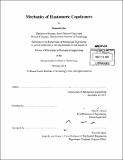| dc.contributor.advisor | Mary C. Boyce. | en_US |
| dc.contributor.author | Cho, Hansohl | en_US |
| dc.contributor.other | Massachusetts Institute of Technology. Department of Mechanical Engineering. | en_US |
| dc.date.accessioned | 2014-06-13T22:38:16Z | |
| dc.date.available | 2014-06-13T22:38:16Z | |
| dc.date.copyright | 2014 | en_US |
| dc.date.issued | 2014 | en_US |
| dc.identifier.uri | http://hdl.handle.net/1721.1/87972 | |
| dc.description | Thesis: Ph. D., Massachusetts Institute of Technology, Department of Mechanical Engineering, 2014. | en_US |
| dc.description | Cataloged from PDF version of thesis. | en_US |
| dc.description | Includes bibliographical references. | en_US |
| dc.description.abstract | Elastomeric copolymers have been versatile materials for a broad variety of engineering applications of critical importance ranging from ballistic protective coatings to self-healing microstructures, possessing a backbone structure composed of alternate hard and soft segments, where the hard/soft nomenclature corresponds to the thermodynamic glassy/rubbery state at ambient temperature. The thermodynamic incompatibility of microstructures often lead to a phase-separated morphology of the hard and soft domains which can be tailored depending on the chemical composition, molecular dispersion, processing and synthesis to give a variety of physical properties. The mechanical behavior of elastomeric copolymers is hence governed by the chemical composition as well as the morphology providing a hybrid performance by virtue of simultaneous contributions from constituent homopolymers often offering new and unique properties. In this research, the mechanics and physics of large deformation behavior of elastomeric copolymers are addressed in terms of their resilience and dissipation involving elastomeric "segmented" copolymers and elastomeric "ionic" copolymers. The presence of hard and soft domains yields to multiple molecular relaxations and hence multiple viscous dissipation mechanisms in elastomeric copolymers. In addition to the viscous dissipation, stretch-induced softening due to microstructural evolution revealed via x-ray scattering observation during deformation provides another major dissipation pathway. Furthermore the segmented copolymers exhibit a substantial shape recovery upon unloading in tandem with a remarkable amount of hysteresis. A microstructurally-informed constitutive model is proposed to address the main features of mechanical behavior of exemplar copolymers under a variety of loading conditions, employing multiple micro-rheological mechanisms representing hard and soft domains. The proposed model was found to be capable of capturing the salient features of resilient yet dissipative stress-strain behavior of materials at a wide range of strains and strain rates. The model was then furthered to examine the effect of weight fraction, morphology and segmental dynamics of hard and soft microstructures. Next, the resilience and dissipation in elastomeric segmented copolymers are examined in their connections to shape recovery under microindentation testing in experiments and numerical simulations. Numerical simulations imparting the proposed constitutive model were found to be capable of capturing the microindentation behavior of materials including force-displacement capable of capturing the microindentation behavior of materials including force-displacement responses under complicated loading scenarios. Additionally, the microindentation behavior revealed a substantial shape recovery of indented surfaces which was due to inelastic flow beyond elastic resilience. The elastically- and inelastically-driven shape recovery provides critical insight into a better understanding of shape memory, recovery and self-healing mechanisms in this class of segmented elastomers. The extreme nature of elastomeric copolymers under harsh mechanical environments is then addressed via Taylor impact testing, where an ultrafast deformation event is incurred. Numerical simulations of Taylor impact behavior of elastomeric copolymers are compared to experimental results in terms of overall and localized deformation profiles, revealing a three-dimensional capability of our framework under dynamic, inhomogeneous deformation field. Furthermore, energy dissipation under such an extreme event is examined by comparison to that found in "model" glassy and rubbery polymers revealing that copolymeric materials enable a highly recoverable, protective composite architecture for shock and ballistic mitigation by taking advantages of hybrid performance of glassy and rubbery polymers. Lastly, the mechanics of elastomeric "ionic" copolymers is addressed for a broad understanding of their resilience, dissipation and shape recovery under a wide range of mechanical loading conditions. Our viscoelastic-viscoplastic constitutive framework is further developed to address the large deformation behavior of ionic elastomers including ethylene methacrylic acid (EMAA) copolymer and its chemically-modified counterparts which are recently finding new avenues towards multi-functional soft materials involving their self-healing ability under severe deformation events. This study provides a simple yet intuitive framework to rationalize physically-sound deformation mechanisms of diverse elastomeric copolymers by employing a combination of novel modeling, experimentation and computation. Finally, potential topics for further research, to which the present work can directly contribute, are discussed in a wide variety of engineering contexts. | en_US |
| dc.description.statementofresponsibility | by Hansohl Cho. | en_US |
| dc.format.extent | 218 pages | en_US |
| dc.language.iso | eng | en_US |
| dc.publisher | Massachusetts Institute of Technology | en_US |
| dc.rights | M.I.T. theses are protected by copyright. They may be viewed from this source for any purpose, but reproduction or distribution in any format is prohibited without written permission. See provided URL for inquiries about permission. | en_US |
| dc.rights.uri | http://dspace.mit.edu/handle/1721.1/7582 | en_US |
| dc.subject | Mechanical Engineering. | en_US |
| dc.title | Mechanics of elastomeric copolymers | en_US |
| dc.type | Thesis | en_US |
| dc.description.degree | Ph. D. | en_US |
| dc.contributor.department | Massachusetts Institute of Technology. Department of Mechanical Engineering | |
| dc.identifier.oclc | 880689462 | en_US |
